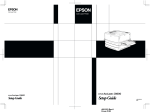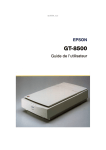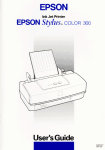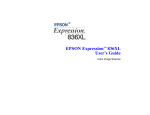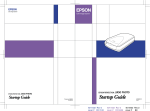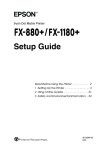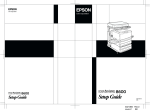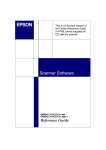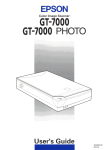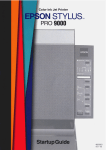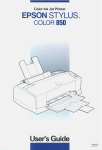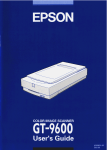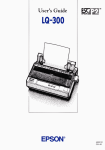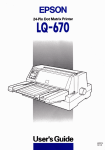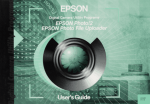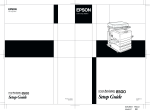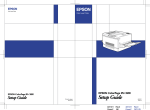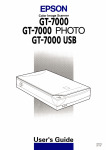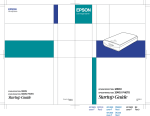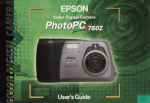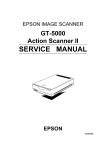Download Epson GT-5500 User's Manual
Transcript
L Proof Sign-off: E. Ohtera D. Grady _______ _______ GT-5500 Rev.C July-18-97 pass 0 Cover Scanner Parts document cover carriage (in the home position) 01 document table OPERATE button lights RESET button transportation screw SCSI ID rotary switch !e2scsi 7 SCSI storage hole * 0 1 6 5 4 ON 2 3 SCSI SCSI interface connectors SW AC inlet terminator switch GT-5500 Rev.C A5 size July-18-97 ® Frontmatter Pass 0, DR GT-5500 Color Image Scanner All rights reserved. No part of this publication may be reproduced, stored in a retrieval system, or transmitted in any form or by any means, electronic, mechanical, photocopying, recording, or otherwise, without the prior written permission of SEIKO EPSON CORPORATION. No patent liability is assumed with respect to the use of the information contained herein. Neither is any liability assumed for damages resulting from the use of the information contained herein. Neither SEIKO EPSON CORPORATION nor its affiliates shall be liable to the purchaser of this product or third parties for damages, losses, costs, or expenses incurred by purchaser or third parties as a result of: accident, misuse, or abuse of this product or unauthorized modifications, repairs, or alterations to this product. SEIKO EPSON CORPORATION and its affiliates shall not be liable against any damages or problems arising from the use of any options or any consumable products other than those designated as Original EPSON Products or EPSON Approved Products by SEIKO EPSON CORPORATION. EPSON is a registered trademark of SEIKO EPSON CORPORATION. IBM and PS/2 are registered trademarks of International Business Machines Corporation. Macintosh is a registered trademark of Apple Computer, Inc. General Notice: Other product names used herein are for identification purposes only and may be trademarks of their respective companies. Copyright © 1997 by SEIKO EPSON CORPORATION, Nagano, Japan. User’s Guide R L GT-5500 Rev.C A5 size July-18-97 Frontmatter Pass 0, DR Declaration of Conformity Manufacturer: Address: SEIKO EPSON CORPORATION 3-5, Owa 3-chome, Suwa-shi, Nagano-ken 392 Japan Representative: Address: EPSON EUROPE B.V. Prof. J. H. Bavincklaan 5 1183 AT Amstelveen The Netherlands Declares that the Product: Product Name: Type Name: Model: Image Scanner GT-5500 G670B Conforms to the following Directive(s) and Norm(s): Directive 89/336/EEC: EN 55022 Class B EN 61000-3-2 EN 61000-3-3 EN 50082-1 IEC 801-2 IEC 801-3 IEC 801-4 Directive 73/23/EEC: EN 60950 August, 1997 Y. Ishii President of EPSON EUROPE B.V. ii GT-5500 Rev.C Proof Sign-off: E. Ohtera D. Grady A5 size July-18-97 R Frontmatter Pass 0, DR Contents Introduction Features . . . . . . . . . . . . . . Options . . . . . . . . . . . . . . Warnings, Cautions, and Notes Important Safety Instructions . For United Kingdom Users . . Safety information . . . . . . . . . . . . . . . . . . . . . . . . . . . . . . . . . . . . . . . . . . . . . . . . . . . . . . . . . . . . . . . . . . . . . . . . . . . . . . 1-1 1-1 1-2 1-2 1-4 1-4 Choosing a Place for the Scanner . . . . . . Removing the Transportation Screw . . . . Plugging In the Scanner . . . . . . . . . . . Initialization . . . . . . . . . . . . . . . . . . Connecting the Scanner to Your Computer Understanding SCSI connections . . . . Setting the SCSI ID number . . . . . . . Setting the terminator switch . . . . . . Connecting the scanner . . . . . . . . . Power-on sequence . . . . . . . . . . . . Power-off sequence . . . . . . . . . . . . . . . . . . . . . . . . . . . . . . . . . . . . . . . . . . . . . . . . . . . . . . . . . . . . . . . . . . . . . . . . . . . . . . . . . . . . . . . . . . . . . . . . . . . . . . . . . . . . . . . . . . . . . . . . . . . . . . . . . . . . . 1-2 1-3 1-4 1-5 1-6 1-6 1-7 1-8 1-10 1-11 1-12 Chapter 1 . . . . . . . . . . . . . . . . . . . . . . . . . . . . . . . . . . . . Setting Up the Scanner iii L GT-5500 Rev.C A5 size July-18-97 Frontmatter Pass 0, DR Chapter 2 Using Your Scanner Lights and Buttons . . . . . . . . . . . . . . . . . . . Placing a Document on the Scanner . . . . . . . . . Removing the Cover for Thick or Large Documents Sizing Up Your System . . . . . . . . . . . . . . . . RAM and hard disk size . . . . . . . . . . . . . . Accelerator boards . . . . . . . . . . . . . . . . . Video cards . . . . . . . . . . . . . . . . . . . . . Monitors . . . . . . . . . . . . . . . . . . . . . . . File compression software . . . . . . . . . . . . . Chapter 3 . . . . . . . . . . . . . . . . . . . . . . . . . . . . . . . . . . . . . . . . . . . . . . . . . . . . . . . . . . . . . . . 2-2 2-4 2-6 2-7 2-7 2-8 2-8 2-8 2-8 Maintenance and Troubleshooting Maintenance . . . . . . . . . . . . . . Cleaning the scanner . . . . . . . Replacing the fluorescent lamps Transporting the Scanner . . . . . . Problems and Solutions . . . . . . . Error indicators . . . . . . . . . . Operating problems . . . . . . . Quality problems . . . . . . . . . . . . . . . . . . . . . . . . . . . . . . . . . . . . . . . . . . . . . . . . . . . . . . . . . . . . . . . . . . . . . . . . . . . . . . . . . . . . . . . . . . . . . . . . . . . . . . . . . . . . . . . . . . . . . . . . . . . . . . . . . . . . . . . . . 3-2 3-2 3-3 3-3 3-4 3-4 3-5 3-7 . . . . . . . . . . . . . . . . . . . . . . . . . . . . . . . . . . . . . . . . . . . . . . . . . . . . . . . . . . . . . . . . . . . . . . . . . . . . . . . . . . . . A-2 A-3 A-4 A-4 A-5 A-6 Appendix A Technical Specifications Scanning . . . . . . . . Electrical . . . . . . . . Environmental . . . . Safety Approvals . . . SCSI Interface . . . . . Initialization Methods iv . . . . . . . . . . . . . . . . . . . . . . . . . . . . . . . . . . . . . . . . . . . . . . . . . . . . . . . . . . . . GT-5500 Rev.C A5 size July-18-97 R Frontmatter Pass 0, DR Appendix B Contacting Customer Support For United Kingdom and the Republic of Ireland Users For Australian Users . . . . . . . . . . . . . . . . . . . . For Singapore Users . . . . . . . . . . . . . . . . . . . . . For Hong Kong Users . . . . . . . . . . . . . . . . . . . . For Philippines Users . . . . . . . . . . . . . . . . . . . . . . . . . . . . . . . . . . . . . . . . B-2 B-4 B-5 B-5 B-6 Glossary Index v L GT-5500 Rev.C A5 size July-18-97 vi Frontmatter Pass 0, DR Proof Sign-off: E. Ohtera D. Grady _______ _______ GT-5500 Rev.C A5 size July-18-97 R Intro Pass 0, DR Introduction Features The EPSON GT-5500 scanner offers the following features: ❑ Maximum optical resolution of 400 dots per inch (dpi), 30-bit (for input, 24-bit for output), single/triple pass graphics scanner. ❑ Small and light body with A4 or letter size scanning area. ❑ Twice the scan speed of the EPSON GT-5000. ❑ Full color or grayscale (varying shades of gray, from black to white) scanning. You can scan full color (16 million colors), 256 colors, or grayscale up to 256 grays. ❑ The EPSON Scan! II scanner utility and EPSON TWAIN let you take full advantage of your scanner’s advanced features. ❑ Auto Area Segmentation (AAS) allows you to separate text from photographs on a page so that grayscale images are clearer and text recognition is more accurate. ❑ Text Enhancement Technology (TET) enhances text recognition accuracy when using your scanner for optical character recognition (OCR) scanning. ❑ A special feature for higher quality output with EPSON TWAIN’s “Best & de-screening” option automatically removes unwanted moiré patterns from scanned images. Options The following cables are available to expand the versatility of your scanner. For detailed information on the use of these cables, see the guides that come with them. Introduction 1 L GT-5500 Rev.C A5 size July-18-97 Intro Pass 0, DR SCSI System Cable (25-pin to 50-pin) (B860081) This cable provides a connection between a SCSI device and an Apple® Macintosh® computer. SCSI Peripheral Cable (50-pin to 50-pin) (B860091) This cable provides a connection between two SCSI devices in a daisy chain. Warnings, Cautions, and Notes w c Warnings must be followed carefully to avoid bodily injury. Cautions must be observed to avoid damage to your equipment. Notes contain important information and useful tips on the operation of your scanner. Important Safety Instructions Read all of these instructions and save them for later reference. Follow all warnings and instructions marked on the scanner. 2 ❑ Unplug the scanner before cleaning. Clean with a damp cloth only. Do not spill liquid on the scanner. ❑ Do not place the scanner on an unstable surface or near a radiator or heat source. ❑ Do not block or cover the openings in the scanner’s cabinet. Do not insert objects through the slots. ❑ Use only the type of power source indicated on the scanner’s label. Introduction GT-5500 Rev.C A5 size July-18-97 R Intro Pass 0, DR ❑ Connect all equipment to properly grounded power outlets. Avoid using outlets on the same circuit as photocopiers or air control systems that regularly switch on and off. ❑ Do not let the power cord become damaged or frayed. ❑ If you use an extension cord with the scanner, make sure the total ampere rating of the devices plugged into the extension cord does not exceed the cord’s ampere rating. Also, make sure the total ampere rating of all devices plugged into the wall outlet does not exceed the wall outlet’s ampere rating. ❑ Except as specifically explained in this user’s guide, do not attempt to service the scanner yourself. ❑ Unplug the scanner and refer servicing to qualified service personnel under the following conditions: If the power cord or plug is damaged; if liquid has entered the scanner; if the scanner has been dropped or the cabinet damaged; if the scanner does not operate normally or exhibits a distinct change in performance. Adjust only those controls that are covered by the operating instructions. ❑ If you plan to use the scanner in Germany, observe the following: To provide adequate short-circuit protection and over-current protection for this scanner, the building installation must be protected by a 16 Amp circuit breaker. Note for German-speaking users: Bei Anschluß des Scanners an die Stromversorgung muß sichergestellt werden, daß die Gebäudeinstallation mit einem 16 A-Überstromschalter abgesichert ist. Introduction 3 L GT-5500 Rev.C A5 size July-18-97 Intro Pass 0, DR For United Kingdom Users Safety information w Warning: This appliance must be earthed. Refer to the rating plate for voltage and check that the appliance voltage corresponds to the supply voltage. Important: The wires in the mains lead fitted to this appliance are coloured in accordance with the following code: Green and yellow — Earth Blue — Neutral Brown — Live As the colours of the wires in the mains lead of this appliance may not correspond with the coloured markings identifying the terminals in your plug, proceed as follows: The green and yellow wire must be connected to the terminal in the plug which is marked with the letter E or with the earth symbol (G). The blue wire must be connected to the terminal in the plug marked with the letter N. The brown wire must be connected to the terminal in the plug marked with the letter L. If damage occurs to the plug, replace the cord set or consult a qualified electrician. Replace fuses only with a fuse of the correct size and rating. 4 Introduction Proof Sign-off: E. Ohtera D. Grady _______ _______ GT-5500 Rev.C A5 size July-18-97 R Chapter 1 Pass 0, DR Chapter 1 Setting Up the Scanner 1 Choosing a Place for the Scanner . . . . . . . . . . . . . . . . . 1-2 Removing the Transportation Screw . . . . . . . . . . . . . . . 1-3 Plugging In the Scanner . . . . . . . . . . . . . . . . . . . . . . 1-4 Initialization . . . . . . . . . . . . . . . . . . . . . . . . . . . . . 1-5 Connecting the Scanner to Your Computer Understanding SCSI connections . . . . Setting the SCSI ID number . . . . . . . Setting the terminator switch . . . . . . Connecting the scanner . . . . . . . . . Power-on sequence . . . . . . . . . . . . Power-off sequence . . . . . . . . . . . . 1-6 1-6 1-7 1-8 1-10 1-11 1-12 . . . . . . . . . . . . . . . . . . . . . . . . . . . . . . . . . . . . . . . . . . . . . . . . . . . . . . . . . . . . . . . . . . . . . . . . . . . . . Setting Up the Scanner 1-1 L GT-5500 Rev.C A5 size July-18-97 Chapter 1 Pass 0, DR Choosing a Place for the Scanner Follow the guidelines listed below when selecting a location for your scanner: ❑ Place the scanner on a flat, stable surface. The scanner will not operate properly if it is tilted or at an angle. ❑ Place the scanner close enough to the computer for the interface cable to reach it easily. ❑ Allow some space behind the scanner for the cables, and make sure to place the scanner where you can easily unplug the power cord. Also allow sufficient space above the scanner so that you can fully raise the document cover. 150 mm or more 443 mm 87 mm 150 mm or more 297 mm 443 mm 1-2 ❑ Keep the scanner away from high temperature and humidity. Also avoid using or storing the scanner in places subject to rapid changes of temperature and humidity. ❑ Keep the scanner away from direct sunlight and strong light sources. ❑ Avoid places subject to shocks and vibrations. Setting Up the Scanner 18.eps GT-5500 Rev.C A5 size July-18-97 R Chapter 1 Pass 0, DR Removing the Transportation Screw Before connecting the scanner to a power source, you must remove the transportation screw. 1. Place the scanner on a flat, stable surface with its rear panel facing you. 2. Remove the screw located in the middle of the rear panel by turning it counter-clockwise, as shown below. If necessary, turn the screw with a coin or screwdriver to loosen it. 02 SCSI *0 1 7 6 5 4 2 3 SCSI ON SW 3. Push the screw into the storage hole marked STOCK. It does not screw in. Make sure you push it all the way into the hole. 03 SCSI *0 1 7 6 5 4 2 3 SCSI ON SW Note: Do not discard the transportation screw. It must be replaced when storing or transporting the scanner. Setting Up the Scanner 1-3 L GT-5500 Rev.C A5 size July-18-97 Chapter 1 Pass 0, DR Plugging In the Scanner 1. Make sure that the scanner is turned off. It is off when the OPERATE button protrudes from the surface of the front panel. 08 OPER ATE RESET 2. Connect the power cable to the power inlet on the rear of the scanner and plug the other end into a properly grounded outlet. 04 SCSI *0 1 7 6 5 4 2 3 SCSI ON SW c 1-4 Caution: It is not possible to change the scanner’s voltage. If the label on the back of the scanner does not show the correct voltage for your country, contact your dealer. Setting Up the Scanner GT-5500 Rev.C A5 size July-18-97 R Chapter 1 Pass 0, DR Initialization Before connecting the scanner to your computer, follow the steps below to make sure that the scanner is operating properly. 1. Open the document cover so you can see the operation of the scanner during initialization (startup). 2. Turn on the scanner by pressing the OPERATE button. The OPERATE light comes on. 3. Make sure the fluorescent lamps on the carriage flash, and the carriage moves slightly. 4. The READY light comes on. This means the scanner has completed its initialization. 5. Turn off the scanner. If the scanner does not work as described, make sure that the power cord is firmly plugged in and that you have removed the transportation screw, then try again. c Caution: Whenever you turn off the scanner, wait at least 10 seconds before turning it back on. Rapidly turning it on and off can damage the scanner. Setting Up the Scanner 1-5 L GT-5500 Rev.C A5 size July-18-97 Chapter 1 Pass 0, DR Connecting the Scanner to Your Computer For PC users: If your PC does not have a SCSI board installed, you need to install one according to the directions that come with the SCSI board. If your PC already has a SCSI board, connect the scanner as described in the next section. Note: If you use Windows 95 or NT, install the SCSI driver included in Windows 95 or NT (see your system documentation for instructions) or the driver described in the SCSI board installation documentation. If you use Windows 3.1, install the driver packed with the SCSI board, as described in the SCSI board installation documentation. For Macintosh users: All Macintosh computers have SCSI ports; you do not need to install a SCSI board in a Macintosh. Follow the directions below to connect your scanner and computer. Understanding SCSI connections Read the following sections to help determine how to set up your SCSI device(s) and if you need any optional SCSI cables. Daisy Chain The SCSI interface allows you to connect up to seven devices (such as scanner, hard disk, CD-ROM, and so on) to the computer, in what is called a “daisy chain” arrangement. Only the first SCSI device in a daisy chain is connected to the computer; each of the other devices is connected to another SCSI device. 16 1-6 Setting Up the Scanner GT-5500 Rev.C A5 size July-18-97 R Chapter 1 Pass 0, DR SCSI Cables Before purchasing a SCSI cable or setting up your SCSI daisy chain, be sure your SCSI cable(s) has the right combination of 50-pin and 25-pin connectors. The combination you need varies depending on the maker of your SCSI device and SCSI interface board. SCSI ID and terminator Each device has a SCSI ID number: the computer is usually number 7, and each of the other devices must have a different number between 0 and 6. Also, the first device and the last device in the chain (not including the computer) must have a terminator. No other device can have a terminator or if a terminator does exist, it must be turned off. Setting the SCSI ID number The scanner’s default SCSI ID number is 2. * 7 SCSI *0 1 7 6 5 4 2 3 6 0 1 5 4 2 3 05 The SCSI ID rotary switch is located at the rear of the scanner. SCSI ON SW If you add the scanner to a system in which one of your SCSI devices already has a SCSI ID of 2, change the ID number of the scanner to an unused number. See the table on the next page as a guide. Setting Up the Scanner 1-7 L GT-5500 Rev.C A5 size July-18-97 Chapter 1 Pass 0, DR ID Availability Description 0 Not available for Macintosh Used for hard disk Not recommended for Windows Usually used for hard disk Not recommended Usually used for hard disk 1 2 Factory setting of the scanner 3 Not available if your Macintosh has a built-in CD-ROM 4 5 6 7 * 1 Not available for Macintosh Always used for the Macintosh itself May not be available for Windows Usually used for the SCSI board Not available Never selected1 Otherwise the scanner does not work properly. c Caution: Do not set the SCSI ID to an ID number that is already assigned to another device. Otherwise the computer, scanner, and other devices will not function properly. Setting the terminator switch The scanner has a built-in terminator, which allows SCSI devices to communicate properly with each other. You may need to change the terminator switch setting according to your computer system. 1-8 Setting Up the Scanner GT-5500 Rev.C A5 size July-18-97 R Chapter 1 Pass 0, DR Note: Do not use an external terminator. 06 ON SCSI *0 1 7 6 The terminator switch is located at the rear of the scanner. 5 4 2 3 SCSI ON SW SW only the scanner is connected 16-1 terminator on the scanner is the last device in the daisy chain 16-2 (other SCSI device) terminator on the scanner is in the middle of the daisy chain 16-3 terminator off (other SCSI device) Setting Up the Scanner 1-9 L GT-5500 Rev.C A5 size July-18-97 Chapter 1 Pass 0, DR Connecting the scanner Connect the scanner to your computer or to another SCSI device as follows: Note: The combination of 50-pin and 25-pin connectors you need varies depending on the maker of your SCSI device and SCSI interface board. 1. Make sure the scanner, computer, and all other SCSI devices are turned off and unplugged from the power source. c Caution: Do not connect the scanner to the computer or other devices while they are turned on; otherwise damage may occur. 2. Connect one end of the cable to the scanner SCSI connector; then squeeze the wire clips together until they lock in place on both sides. 07 PARA LLEL SW 1 2 ON This is an example using the scanner’s 50-pin interface. Note: ❑ To connect the scanner to a SCSI device other than the computer, the length of cable in the daisy chain must be 6 meters or less; otherwise the system may not work properly. ❑ 1-10 To connect the scanner to a PC using SCSI-2, the length of the cable must be 3 meters or less. Setting Up the Scanner GT-5500 Rev.C A5 size July-18-97 R Chapter 1 Pass 0, DR 3. Connect the other end of the cable to the SCSI port of your computer or another SCSI device. Note: The SCSI port of the Macintosh is the larger port with the SCSI icon over it. 4. Connect the power cables of your computer, scanner, and other external SCSI devices. Note: Before turning on your system, be sure to read “Power-on sequence” below. Power-on sequence Keep the following in mind every time you turn on your computer and SCSI devices (such as the scanner). ❑ Be sure to turn on SCSI devices first, then your computer. If you attempt to use a SCSI device which has been turned on after the computer, it may not work properly, or the computer may not work properly. Setting Up the Scanner 1-11 L GT-5500 Rev.C A5 size July-18-97 Chapter 1 Pass 0, DR ❑ For Windows 95 users: The first time you turn on the computer after turning on the scanner, either of the following dialog boxes may appear. device2, osr2a If you see either of these, follow the installation instructions in Chapter 1 of your scanner software manual, and then see “Power-off sequence” below. Power-off sequence Keep the following in mind every time you turn off your computer and SCSI devices. ❑ When you are finished using your system, turn off your computer first, then the scanner and other SCSI devices. ❑ While using your computer, do not turn off the SCSI device whose terminator is active (on). ❑ Do not turn the scanner off and back on while using your computer, otherwise the scanner may not scan properly. Now that the connection is completed, you need to install the scanner software. See Chapter 1 of your scanner software manual. 1-12 Setting Up the Scanner Proof Sign-off: E. Ohtera D. Grady GT-5500 Rev.C _______ _______ A5 size July-18-97 R Chapter 2 Pass 0, DR Chapter 2 Using Your Scanner Lights and Buttons . . . . . . . . . . . . . . . . . . . . . . . . . . 2-2 Placing a Document on the Scanner . . . . . . . . . . . . . . . . 2-4 Removing the Cover for Thick or Large Documents . . . . . . 2-6 Sizing Up Your System . . . . RAM and hard disk size . Accelerator boards . . . . . Video cards . . . . . . . . . Monitors . . . . . . . . . . File compression software . . . . . . . . . . . . . . . . . . . . . . . . . . . . . . . . . . . . . . . . . . . . . . . . . . . . . . . . . . . . . . . . . . . . . . . . . . . . . . . . . . . . . . . . . . . . . . . . . . . . . . . . . . . . . . . . . . Using Your Scanner 2-7 2-7 2-8 2-8 2-8 2-8 2-1 2 L GT-5500 Rev.C A5 size July-18-97 Chapter 2 Pass 0, DR This chapter shows you how the scanner operates. The basic procedure for scanning is as follows. 1. Turn on the scanner. (Keep in mind the ’Power-on sequence’ on page 1-11.) 2. Place the document or material you want to scan on the document table. (This is described in detail on page 2-4.) 3. Run the scanner software and enjoy scanning. (See your scanner software manual for details on scanning.) Lights and Buttons The scanner has three indicator lights and two buttons. OPERA 10 TE RESE T buttons lights 2-2 Using Your Scanner GT-5500 Rev.C A5 size July-18-97 R Chapter 2 Pass 0, DR Lights Indicator ERROR (red) READY (green) OPERATE (green) Printer Status o/f o o/f o An error occurred. This light, along with the READY light, indicates the type of error as shown on page 3-4. Ready to scan images. Along with the ERROR light, indicates the type of error. See page 3-4 for troubleshooting information. The scanner is turned on. o = on, f = flashing Buttons Button OPERATE RESET Function Turns the scanner on and off. Resets the scanner after an error. Do not press this button while scanning, or you may cause an error. Using Your Scanner 2-3 L GT-5500 Rev.C A5 size July-18-97 Chapter 2 Pass 0, DR Placing a Document on the Scanner Before scanning a document: Remember to respect the rights of copyright owners. Do not scan published text or images without first checking the copyright status. 1. Turn on the scanner, if necessary, by pressing the OPERATE button. The OPERATE light comes on. 08 OPER ATE RESE T 2. Turn on the computer and make sure that the scanner’s READY light is on. 3. Open the document cover. 09 Caution: Do not open the document cover forcefully, or you may damage the cover’s hinge. 2-4 Using Your Scanner GT-5500 Rev.C A5 size July-18-97 R Chapter 2 Pass 0, DR 4. Place the document on the document table, with the side to be scanned facing down. Make sure that the document is carefully aligned. 11 corner of the document 5. Close the document cover gently so that the document does not move. 12 Using Your Scanner 2-5 L GT-5500 Rev.C A5 size July-18-97 Chapter 2 Pass 0, DR Note: ❑ Make sure the document is flat against the glass surface; otherwise the scanner cannot properly focus and scan your image. Also, make sure to close the document cover. This prevents interference from external light. ❑ Always keep the document table clean. See “Cleaning the Scanner” in Chapter 3. ❑ Do not leave photographs on the document table for an extended period of time; they may stick to the glass. ❑ Do not place heavy objects on top of the scanner. 6. Start your scanner software, and follow scanning instructions in your scanner software manual. Removing the Cover for Thick or Large Documents For thick materials or documents that are larger than the document table, remove the document cover. 13 Hold the back of the document cover and lift straight up. Note: When scanning with the cover removed, make sure you cover any exposed areas of the document table to prevent interference from external light. 2-6 Using Your Scanner GT-5500 Rev.C A5 size July-18-97 R Chapter 2 Pass 0, DR When you are finished scanning, reattach the document cover by pushing straight down on the back of it until it clicks into place. 14 c Caution: Make sure that both of the cover’s notches are directly above the clips on the scanner before pushing the cover down into place; otherwise you may damage the cover. Sizing Up Your System Your scanner is sufficient for most scanning needs, but if you are not satisified with the quality of the images on your monitor or with the speed of image processing, read this section. While it does not contain specific recommendations, it describes various possibilities for improving your scanning system. For further information, see your dealer or an experienced scanner user. RAM and hard disk size Scanned images use much more memory than text files, so you may need more RAM (Random Access Memory) in your computer and a larger hard disk than you have used previously. Using Your Scanner 2-7 L GT-5500 Rev.C A5 size July-18-97 Chapter 2 Pass 0, DR Accelerator boards In addition to memory, processing speed is important because large files take longer to process than small ones. Therefore, you may want to add an accelerator board to your computer. Video cards A video card that is sufficient for text may not be good enough for displaying graphic images, especially in color. If all your scanned images look coarse on your monitor, you may want to upgrade your video card. You will need 24-bit color, also called true color or millions of colors, to make the highest quality image reproductions. Monitors The resolution of your monitor affects the quality of the image you see. Consider a high resolution monitor if you do precise color work, but also be sure you have a high quality video card. File compression software Many different programs are available to make image files smaller for storage or transmission. For example, some compression software can store a 3MB image file on a 1.44MB floppy disk, and compress images and restore them with no loss of data or quality; others compress images more, but the restored file is not exactly the same as the original. The difference between the original and restored files is, however, almost unnoticeable. 2-8 Using Your Scanner Proof Sign-off: E. Ohtera G. Grady GT-5500 Rev.C _______ _______ A5 size July-18-96 R Chapter 3 Pass 0, DR Chapter 3 Maintenance and Troubleshooting Maintenance . . . . . . . . . . . . . . . . . . . . . . . . . . . . . Cleaning the scanner . . . . . . . . . . . . . . . . . . . . . . Replacing the fluorescent lamps . . . . . . . . . . . . . . . . 3-2 3-2 3-3 Transporting the Scanner . . . . . . . . . . . . . . . . . . . . . 3-3 . . . . 3-4 3-4 3-5 3-7 Problems and Solutions Error indicators . . . Operating problems . Quality problems . . . . . . . . . . . . . . . . . . . . . . . . . . . . . . . . . . . . . . . . . . . . . . . . . . . . . . . . . . . . . . . . . . . . . . . . . . . . . . . . . . . . . . 3 Maintenance and Troubleshooting 3-1 L GT-5500 Rev.C A5 size July-18-96 Chapter 3 Pass 0, DR Maintenance Cleaning the scanner To keep your scanner operating at its best, you should clean it periodically, as described below. 1. Unplug the power cable. 2. Clean the outer case with mild detergent diluted in water. 3. If the glass of the document table gets dirty, clean it with a soft dry cloth. If the glass is stained with grease or some other hard-to-remove material, use a small amount of glass cleaner on a soft cloth to remove it. Wipe off any remaining liquid with a dry cloth. Be sure that there is no dust on the glass of the document table. Dust can cause white spots in your scanned image. c 3-2 Caution: ❑ Be careful not to scratch or damage the glass of the document table, and do not use a hard or abrasive brush to clean it. A damaged glass surface can decrease the scanning quality. ❑ Never use alcohol, thinner, or corrosive solvent to clean the scanner. These chemicals can damage the scanner components as well as the case. ❑ Be careful not to spill liquid into the scanner mechanism or electronic components. This could permanently damage the mechanism and circuitry. ❑ Do not spray lubricants inside the scanner. ❑ Never open the scanner case. Maintenance and Troubleshooting GT-5500 Rev.C A5 size July-18-96 R Chapter 3 Pass 0, DR Replacing the fluorescent lamps The luminosity of the fluorescent lamps declines over time. If the lamps break or become too dim to operate normally, the scanner stops working and both the READY and ERROR lights flash. When this happens, the lamp assembly must be replaced. For details, contact your dealer. c Caution: Never open the case of the scanner. If you think repairs or adjustments are necessary, consult your dealer. Transporting the Scanner If you transport the scanner a long distance or store it for an extended period, follow the steps below to secure the carriage. 1. Turn on the scanner and wait until the carriage moves to the home position (position nearest the cover hinge). Then turn off the scanner. 2. Remove the transportation screw from the storage hole marked STOCK and screw it into the center hole. 15 SCSI *0 1 7 6 5 4 2 3 SCSI ON SW Note: If the scanner is broken, the carriage may not automatically return to the home position. If it does not, raise the front of the scanner and hold it up until the carriage comes to rest in the home position. Then perform step 2 above. Maintenance and Troubleshooting 3-3 L GT-5500 Rev.C A5 size July-18-96 Chapter 3 Pass 0, DR Problems and Solutions This section divides scanner problems into three categories: Error indicators ................page 3-4 Operating problems ........page 3-5 Quality problems .............page 3-7 See the table in “Error indicators” first, and if the information there does not help you solve the problem, go to the category for the type of problem you have and look for the description that most closely matches the problem. Error indicators If an error occurs, the scanner stops operating and the READY and ERROR lights show the type of error. Pattern of lights Problem and solution Cause: ERROR READY o o ERROR READY f n The scanner has received incorrect commands from your scanning software. What to do: Check your software settings and try scanning again. The scanner returns to normal when it receives correct commands. Resetting the scanner has no effect. Cause: The interface setup is wrong, or the scanner is not properly connected to the computer. What to do: Check the interface connection. Then push the RESET button or turn the scanner off and back on to reset it. Cause: ERROR READY f f The transportation screw has not been removed. Or, one or more fluorescent lamps need to be replaced. Or, the scanner is broken. What to do: Check that the transportation screw has been removed; then push the RESET button. If the scanner still does not operate properly, try turning the scanner off and then back on. If the scanner still does not operate properly, or if this error occurs repeatedly, consult your dealer. o = on, n = off, f = flashing 3-4 Maintenance and Troubleshooting GT-5500 Rev.C A5 size July-18-96 R Chapter 3 Pass 0, DR Operating problems The problems you may have while using the scanner often involve the operation of your software and computer. Operation problems usually occur because of: ❑ Incorrect setup of the interface (see Chapter 1). ❑ Inappropriate selection of the scanner functions (see your software manual). ❑ Incorrect setup of your computer or software (see Chapter 1 in this guide or the software manual). ❑ Incorrect operation of your software (see your software manual). Also see the documentation that came with your computer and printer for possible solutions. The OPERATE light does not come on. Press the OPERATE button to turn on the scanner. Make sure the power cable is correctly plugged into the scanner and the power outlet. The READY light does not come on. Make sure the scanner is correctly connected to the computer and that the computer is turned on. The scanner does not start scanning. Make sure that the READY light is on. Maintenance and Troubleshooting 3-5 L GT-5500 Rev.C A5 size July-18-96 Chapter 3 Pass 0, DR Make sure that you have selected the correct interface port and settings with your software. Also make sure the interface board in your computer is properly installed. Make sure that the terminator and SCSI ID are correctly set up. See page 1-7. If you have other expansion boards in your computer, make sure that they are not interfering with the interrupt setting of the interface board for your scanner. (See your computer manual.) The scanner software does not work properly. Be sure you have correctly installed your software. Make sure that your computer system meets the requirements, such as the operating system version, specified for your software. Confirm that the computer has enough memory for your software. If your computer has many device drivers, or if you are running other software at the same time, or are using RAM-resident programs, the computer may not have enough memory left. (See your software and computer manuals.) 3-6 Maintenance and Troubleshooting GT-5500 Rev.C A5 size July-18-96 R Chapter 3 Pass 0, DR Quality problems The entire image is distorted or blurred. Make sure that the document is placed flat against the document table. You may have accidentally moved the document during scanning. Check the position of the document and do not move it while the scanner is operating. See that the scanner is not tilted or placed on an unstable surface. Part of the image is distorted or blurred. Part of the document may be wrinkled, warped, or not in contact with the document table. Be sure the document is uniformly flat. c Caution: Do not place heavy objects on the document table. Edges of the document are not scanned. The document table has non-readable areas around the edges. If part of your document extends beyond the maximum limits marked on the document table edge guides, you may have to reposition your document so that the image you want to scan is within the readable area. Color is patchy or distorted at the edges of the image. If the document is very thick or warped at the edges, the edges of the image may be discolored. Cover the edges of the document with opaque paper to block outside light. Maintenance and Troubleshooting 3-7 L GT-5500 Rev.C A5 size July-18-96 Chapter 3 Pass 0, DR If part of the document extends beyond the document table, that edge may not be in contact with the document table. Change the position of the document. The image is faint or out of focus. Check that the document is placed flush against the document table. Check the Gamma setting in your software. Check the Exposure setting in your software. The image is too dark. Adjust the brightness with your software. Also check the brightness and contrast values of your display screen. Straight lines in the image are jagged. The document may be placed at an angle on the document table. Align it so that the horizontal and vertical lines are carefully aligned with the scales on the top and side of the document table. The image does not look the same as the original. Try different combinations of image settings using your scanner software. Your software may not have sufficient color matching and color management features, or these components of your software may not be correctly installed. (See your software and computer manuals.) 3-8 Maintenance and Troubleshooting GT-5500 Rev.C A5 size July-18-96 R Chapter 3 Pass 0, DR If you are importing an image file into your application software, make sure the file format is one your software can read. Also check that the image settings in your application are appropriate for the type of image you want to scan. (See your software manual.) A line of dots is always missing in the scanned image. If this happens in your printed image only, your printer or its print head is probably malfunctioning. (See your printer manual.) If this happens on both your screen and printout, the scanner’s sensor may be malfunctioning. Consult your dealer. When halftoning is used, textured patterns of dots appear on particular areas of an image. This is normal. See the explanation of moiré patterns in the Color Guide. Colors on your monitor are different from those in the original image. Check the image settings in your scanner software, especially data format (bits/pixel/color), gamma correction, and color correction. Try a different combination of these settings. Check the color matching and color management capabilities of your computer, display adapter, and software. Some computers can change the color palette to adjust the colors on your screen. (See your software and computer manuals.) Exact matching of colors is very difficult. The reason for this is explained in your Color Guide. Check your software and monitor manuals for information on color matching and calibration. Maintenance and Troubleshooting 3-9 L GT-5500 Rev.C A5 size July-18-96 Chapter 3 Pass 0, DR Printed colors are different from those in the original image. Exact reproduction of colors is very difficult. The reason for this is explained in your Color Guide. See your software manual or your printing company for guidance on color matching. The printed image is larger or smaller than the original size. The image size settings in your software determine the size of the printed image. Do not use the size of the image on your monitor to judge the printed size. Your image cannot be printed or the printout is garbled. Check that the printer is properly connected with the computer and is correctly set up. (See your printer manual.) Check that your software is properly installed and set up for your printer. (See your software manual.) 3-10 Maintenance and Troubleshooting Proof Sign-off: E. Ohtera G. Grady GT-5500 Rev.C _______ _______ A5 size July-18-97 R Appendix A Pass 0, DR Appendix A Technical Specifications Scanning . . . . . . . . . . . . . . . . . . . . . . . . . . . . . . . A-2 Electrical . . . . . . . . . . . . . . . . . . . . . . . . . . . . . . . A-3 Environmental . . . . . . . . . . . . . . . . . . . . . . . . . . . . A-4 Safety Approvals . . . . . . . . . . . . . . . . . . . . . . . . . . A-4 SCSI Interface . . . . . . . . . . . . . . . . . . . . . . . . . . . . A-5 Initialization Methods A-6 . . . . . . . . . . . . . . . . . . . . . . . A Technical Specifications A-1 L GT-5500 Rev.C A5 size July-18-97 Appendix A Pass 0, DR Scanning Scanner type: Flatbed, color Photoelectric device: Color CCD line sensor Effective pixels: 3400 × 4680 pixels at 400 dpi, 100% Document size: 216 mm × 297 mm (8.5 inches × 11.7 inches) A4 or US letter size (The reading area can be specified from your software.) Scanning resolution: 400 dpi (main, sub) Output resolution: 50 dpi to 1600 dpi in 1 dpi steps Color separation: RGB color filters on CCD Reading sequence: A-2 Monochrome One-pass scanning Color page sequence Three-pass scanning (R, G, B) Color byte sequence One-pass scanning (R, G, B) Color line sequence One-pass scanning (R, G, B) Zoom: 50% to 200% in 1% increments Image data: 10 bits per pixel per color saved as 8 bits per pixel per color maximum Brightness: 7 levels Line Art settings: Fixed threshold Text Enhancement Technology (enable/disable selectable) Halftoning process: AAS (Auto Area Segmentation) Enable/disable selectable 3 halftoning modes (A, B, and C) and 4 dither patterns (A, B, C, and D) for bi-level and quad-level data (2 downloadable dither patterns) Gamma correction: 2 types for CRT display 3 types for printer 1 type for user-defined Technical Specifications GT-5500 Rev.C A5 size July-18-97 R Appendix A Pass 0, DR Color correction: 1 type for CRT display 3 types for printer output (available in color byte sequence mode and color line sequence mode) 1 type for user-defined Interface: SCSI Light source: Xe-gas cold cathode fluorescent lamp Reliability: 100,000 cycles of carriage movements (main unit MCBF) Dimensions: Width: 297 mm (11.9 inches) Depth: 443 mm (17.7 inches) Height: 87 mm (3.5 inches) Weight: Approx. 5 kg (11.1 lb) Electrical This product is also designed for IT power systems with Phase to Phase voltage 220-240V. Input voltage range 100−120 V model 220−240 V model AC 90 to 132 V AC 198 to 264 V Rated frequency 50 to 60 Hz Input frequency 49.5 to 60.5 Hz Rated current Power consumption 0.5 A 0.3 A Approx. 20W Note: Check the label on the back of the scanner for the voltage of your scanner. Technical Specifications A-3 L GT-5500 Rev.C A5 size July-18-97 Appendix A Pass 0, DR Environmental Temperature: Operation 5° C to 35° C (41° F to 95° F) Storage –25° C to 60° C (–13° F to 140° F) Humidity: Operation 10% to 80%, without condensation Storage 10% to 85%, without condensation Operating conditions: Ordinary office or home conditions. Extreme dust should be avoided. Operation under direct sunlight or near a strong light source should be avoided. Note: Specifications are subject to change without notice. Safety Approvals A-4 Safety standards: EN 60950 (VDE) EN 60950 Nordic Deviation (NEMKO) EMC: EN55022 (CISPR Pub 22) class B EN 61000-3-2 EN 61000-3-3 EN 50082-1, IEC 801-2 IEC 802-3 IEC 802-4 Technical Specifications GT-5500 Rev.C A5 size July-18-97 R Appendix A Pass 0, DR SCSI Interface Interface type: ANSI X3T9.2/375R Revision 10L (SCSI) Functions: BUS FREE phase ARBITRATION phase SELECTION/RESELECTION phase COMMAND phase (Logical Unit Number is fixed to 0 and command link function is not supported.) DATA phase Data in phase Data out phase STATUS phase MESSAGE phase MESSAGE IN phase MESSAGE OUT phase ATTENTION condition RESET condition Logic level: TTL compatible Electrical standard: ANSI X3T9.2/375R Revision 10L (SCSI) ID Setting: Selectable from 0 to 7 Terminator: Internal terminator selectable (enable/disable) Connector type: 25/50-pin connectors Connector pin arrangement: 50 pin 25 1 50 26 17a.eps 25 pin 13 25 1 14 Technical Specifications A-5 L GT-5500 Rev.C A5 size July-18-97 Appendix A Pass 0, DR Initialization Methods The scanner can be initialized (returned to a fixed set of conditions) in the following ways: Hardware initialization * When the scanner is turned on. * When the scanner receives a SCSI Reset signal from the SCSI interface. * When you push the RESET button. Software initialization * When software sends the ESC @ (initialize the scanner) command. * When the scanner receives a SCSI Bus Device Message. A-6 Technical Specifications Proof Sign-off: Ohtera Grady _______ _______ GT-5500 Rev.C A5 size 07-18-97 R Appendix B Pass 0 Appendix B Contacting Customer Support For United Kingdom and the Republic of Ireland Users . . . . B-2 For Australian Users . . . . . . . . . . . . . . . . . . . . . . . . B-4 For Singapore Users . . . . . . . . . . . . . . . . . . . . . . . . B-5 For Hong Kong Users . . . . . . . . . . . . . . . . . . . . . . . . B-5 For Philippines Users . . . . . . . . . . . . . . . . . . . . . . . . B-6 Contacting Customer Support B-1 B L GT-5500 Rev.C A5 size 07-18-97 Appendix B Pass 0 If your scanner is not operating properly and you cannot solve your problem with the troubleshooting information in this guide and online help, contact customer support services for assistance. We will be able to help you much more quickly if you are able to give the exact information indicated below. Serial number of your scanner: (The serial number label is on the back of the scanner.) Brand and model of your computer: Scanner software version: (Click the About button on the Help menu in your application for the version number.) Version of Windows (95, 3.1, NT 4.0, and so on): Version of software applications you normally use with your scanner: For United Kingdom and the Republic of Ireland Users If you purchased your scanner in the UK or the Republic of Ireland, Epson (UK) Limited provides a range of customer services and technical support. Note: For customers in the Republic of Ireland, please use the correct dialing codes when dialing the UK telephone numbers listed in the following sections. For example the Enquiry Desk fax number, 01442 227271, should be dialed as 0044 1442 227271 from the Republic of Ireland. Enquiry Desk The enquiry desk team can be contacted by calling 0800 220546 in the UK or 1 800 409132 from the Republic of Ireland, by faxing 01442 227271, and via the Internet at [email protected]. They can provide the following information: B-2 ❑ Information and literature on new EPSON products (also available from Faxon Epson) ❑ Where to purchase genuine EPSON consumables, accessories and options Contacting Customer Support GT-5500 Rev.C A5 size 07-18-97 R Appendix B Pass 0 Customer Support Our Customer Support team can provide the following services: ❑ Technical information on installing, configuring, and operating your EPSON products ❑ Arranging for faulty EPSON products to be repaired within the warranty period For information on contacting our Customer Support team, please see the Service and Support Information booklet that came with your EPSON product. If this booklet is not available, details can be found on Faxon Epson faxback service, EPtec Bulletin Board Service or on EPSON’s World Wide Web site. See below for details. Faxon Epson Contact Faxon Epson faxback service for: ❑ Literature and specifications on the latest EPSON products ❑ Support information including troubleshooting tips, switch settings and driver information To use Faxon Epson, call 01442 227332 using a touch-tone phone. You will be asked to follow a simple routine to register your document request, and once you have entered your telephone and fax numbers, Faxon Epson will fax a copy of the document catalogue to your fax machine. When you have found the documents that you need in the catalogue, call Faxon Epson again and enter the document ID numbers. The documents will be faxed to you automatically. EPtec - Bulletin Board Service Call the Epson Bulletin Board Service on 01442 227479 for the latest drivers and utilities. No membership is required. Make sure that your communications software is set to 8 data bits, 1 stop bit, no parity bit, ANSI terminal mode emulation and a modem speed of up to 28.8 Kbps. Downloading protocols supported include Xmodem, Ymodem and Zmodem. See the documentation that came with your communications software and modem for more information. When you first connect to the Bulletin Board Service, you will be asked for your name, company name, phone number and a password (which you can invent yourself). Contacting Customer Support B-3 L GT-5500 Rev.C A5 size 07-18-97 Appendix B Pass 0 World Wide Web If you can connect to the Internet and have a Web Browser, you can access EPSON’s World Wide Web site at http://www.epson.com. Here you will find information on the latest EPSON products, software drivers, and answers to frequently asked questions. For Australian Users EPSON Australia wishes to provide you with a high level of Customer Service. As well as this User’s Guide, we provide the following sources for obtaining information: EPSON FAXBACK EPSON FAXBACK will fax you the latest specifications and pricing for most EPSON products offered in Australia. There is also technical information including details of the latest software and drivers available. Phone (02) 9903 9075 and the system will guide you through a number of choices before faxing the information to your fax machine. EPSON Bulletin Board System This is where you can download the latest software and drivers. Visit the BBS to check out the latest versions. If you have a modem, phone (02) 9417 5090. Internet URL http://www.epson.com.au Access the EPSON Australia World Wide Web pages. Worth taking your modem here for the occasional surf! You can get the same information as offered on the EPSON FAXBACK and the EPSON Bulletin Board plus more. Your Dealer Don’t forget that your dealer can often help identify and resolve problems. The dealer should always be the first call for advice on problems. They can often solve problems quickly and easily as well as give you advice on the next step to take. B-4 Contacting Customer Support GT-5500 Rev.C A5 size 07-18-97 R Appendix B Pass 0 EPSON Helpdesk EPSON Helpdesk is provided as a final backup to make sure our clients have access to advice. Operators on the Helpdesk can aid you in diagnosing hardware and software problems. They can also advise you on the latest EPSON products and where the nearest dealer or service agent is located. Many types of queries are answered here. The Helpdesk numbers are: Phone: Fax: (02) 9903 9040 (02) 9903 9189 We encourage you to have all the relevant information on hand when you ring. The more information you prepare, the faster we can help solve the problem. This information includes the User’s Guide for your EPSON product, type of computer, operating system, application programs, and any other information you feel is required. For Singapore Users Contact the telephone and fax numbers below: Phone: Fax: (065) 337-7911 (065) 334-1185 For Hong Kong Users To obtain technical support as well as other after-sales services, users are welcome to contact EPSON Hong Kong Limited. Internet home page EPSON Hong Kong has established a local home page in both Chinese and English on the Internet to provide users with the following information: ❑ Product information ❑ Answers to Frequently Asked Questions (FAQs) ❑ Latest versions of EPSON scanner drivers Users can access our World Wide Web home page at: http://www.epson.com.hk. Contacting Customer Support B-5 L GT-5500 Rev.C A5 size 07-18-97 Appendix B Pass 0 Electronic bulletin board system An electronic bulletin board system (BBS) is also available to obtain scanner information and the latest versions of scanner drivers. You can log on to the following number for the BBS service: BBS: (852) 2827-4244 Technical Support Hotline You can also contact our technical staff at the following telephone and fax numbers: Phone: Fax: (852) 2585-4399 (852) 2827-4383 For Philippines Users To obtain technical support as well as other after sales services, users are welcome to contact the EPSON Philippines Representative Office at the telephone and fax numbers below: Phone: Fax: BBS: B-6 (632) 813-6552 (632) 813-6545 (632) 814-0595 Contacting Customer Support Proof Sign-off: E. Ohtera D. Grady _______ _______ R GT-5500 Rev.C A5 size July-18-97 Glossary DR, pass 0 Glossary additive primary colors Primary colors which produce white when mixed in a certain proportion. These are red, green, and blue --- the colors of the scanner lamps and color monitor displays. bi-level data Image data that is composed of 1 bit per pixel. A pixel is represented by a single bit of digital data that can express only 1 (light) or 0 (dark). bit Short for binary digit. The smallest unit of data in computer processing. A bit can represent two values: on and off, or 1 and 0. bit / pixel The unit that indicates the number of bits allocated for a pixel. The larger the bit value, the more detail of a pixel will be reproduced. brightness A scanner function to lighten or darken the output image data. byte A unit of information consisting of eight bits. A byte can represent a control code or character. carriage A component of the scanner that contains the optical sensor and light source for scanning. color correction A method of adjusting the color image data for a particular type of device so that the reproduction results are as close as possible to the original colors. color separation A process to convert full-color images into a limited number of primary colors. The additive primary colors (red, green, and blue) are used by the scanner, and the subtractive primary colors (cyan, magenta, and yellow) plus black are used for printing press separation. daisy chain A SCSI bus arrangement that allows several devices to be connected simultaneously in a line to a single computer. See SCSI. default A set of values used when no other selections have been made. These are sometimes called factory defaults if the original values have not been changed since the scanner has left the factory. dithering A process in which software or an output device simulates continuous tones with groups of dots. Glossary 1 L GT-5500 Rev.C A5 size July-18-97 Glossary DR, pass 0 document The physical item, such as a sheet of paper or a book, that you place on the document table for the scanner to read. dpi Short for dots per inch. A unit of measurement for resolution. The higher the value, the higher the resolution. dropout color A color the scanner does not recognize and ignores. You can select and deselect dropout colors in the scanner software. ESC/I Abbreviation for EPSON Standard Code for Image scanners. A system of commands that allows you to control image scanners from your software. ESC/P Abbreviation for EPSON Standard Code for Printers. A system of commands that allows you to control printers from your software. grayscale Images represented with various shades of gray in addition to black and white. halftoning A method of reproducing images with patterns of dots to improve the quality of the output. home position The position at the rear (nearest the cover hinge position) of the scanner where its carriage rests before a scanning operation. imagesetter A device that uses computer files to produce high-resolution text and graphics output on film or paper. These are usually found in service bureaus and printing companies. impact dot printer A printer that transfers ink onto the paper by striking an ink ribbon with a number of small pins. ink jet printer A printer that transfers ink onto the paper by spraying it through a number of small nozzles. interface A piece of hardware, a method, or a standard used for connection between or among computer devices. line sequence A type of color scanning that separates primary colors line by line. The carriage makes only one pass. monochrome Black and white images, or images represented only by the intensity of luminosity. 2 Glossary R GT-5500 Rev.C A5 size July-18-97 Glossary DR, pass 0 page sequence The type of color scanning in which the entire image is scanned once for each separation color. pixel Short for picture element. Each image is composed of a number of pixels. Pixels are also counted in units of dots. plain bi-level Bi-level image data without the halftoning process. port An interface channel through which data is transmitted between devices. primary colors Basic colors. See additive primary colors and subtractive primary colors. resolution Indication of how finely an image is resolved into pixels. Measured in dots per inch (dpi), pixels per inch (ppi), or samples per inch (spi). scan An operation performed by the sensor and the carriage. The image is divided into pixels by scanning. scanning area The physical size of the image that can be scanned by the scanner. SCSI Small Computer System Interface. This is one method used to connect your computer to peripherals such as scanners, hard disk drives, CD-ROM drives, and so on. SCSI ID The numbers that all devices in a SCSI connection (see daisy chain) use to identify each other. If the same ID number is used by two devices in the same daisy chain, the devices cannot operate properly. subtractive primary colors Primary colors that produce black when mixed in certain proportion. These are cyan, magenta, and yellow. In printing, black is often added to give more definition because mixing of actual inks cannot produce pure black. terminator A device that stops electronic signals, and prevents them from proceeding or returning to other devices. This is necessary to stop one signal from continuously bouncing between devices, which would stop all electronic traffic between those devices. Glossary 3 L GT-5500 Rev.C A5 size July-18-97 Glossary DR, pass 0 threshold A reference point that is used to determine whether data will be processed as “on” or “off”. If the value of the data is larger than the reference point, the data is considered “on”, and if the value is less than the reference point, the data is considered “off”. In the case of color image data, “on” means that a certain color will appear in a pixel or dot, and “off” means that color will not appear there. tone correction A method of adjusting the tone curve so that the reproduction results on different types of output devices have gradations similar to the original image. tone curve The graph that shows the contrast ratio between the input (original image) and output (image data) in image processing. 4 Glossary Proof Sign-off: E. Ohtera D. Grady _______ _______ R GT-5500 Rev.C A5 size July-18-97 Index Pass 0, DR Index A D AAS, 1 Accelerator board, 2-8 Auto Area Segmentation (AAS), 1 Daisy chain, 1-6, 1-9 Document cover, 2-3, 2-6–7 table, 2-5 placing, 2-4, 2-6 B Best & de-screening, 1 Board accelerator, 2-8 SCSI, 1-6 Button, 2-2 OPERATE, 1-4–5, 2-2–3 RESET, 2-2 E Electrical specifications, A-3 Environmental specifications, A-4 ERROR light, 2-2, 3-4 F C Cable power, 1-4 SCSI, 2, 1-7, 1-10 Carriage, 1-5 Cleaning, 3-2 Chain, daisy, 1-6, 1-9 Choosing a place, 1-2 Compression, 2-8 Connecting cable, 1-10 power cable, 1-4 SCSI device, 1-10 to computer, 1-6 Factory set, SCSI ID, 1-7 File compression, 2-8 Fluorescent lamp, 1-5, 3-3 H Hard disk, 2-7 Index IN-1 L GT-5500 Rev.C A5 size July-18-97 Index Pass 0, DR I O Important safety instructions, 2 Indicator lights, 2-2, 3-4 Initialization, 1-5 method, A-6 Installation scanner software, 1-12 screws, 3-3 software, 1-12 Interface cable, 1-2–3, 1-5–7 connecting, 1-10 SCSI cable, 2, 1-7 specifications, SCSI, A-5 OCR, 1 OPERATE button, 1-4–5, 2-2–3 light, 1-5, 2-2–3 Optical Character Recognition (OCR), 1 Options, 1–2 P Lamps, fluorescent, 1-5, 3-3 Lights, 2-2, 3-4 ERROR, 2-2, 3-4 OPERATE, 1-5, 2-2–3 READY, 1-5, 2-2–4 Peripheral cable, SCSI, 1–2 Placing document, 2-3 scanner, 1-2 Plugging in, 1-4 Port (SCSI), 1-6, 1-11 Power cable, 1-4 Power-on sequence, SCSI, 1-11 Power-off sequence, 1-12 Problems and solutions, 3-4 M R Macintosh SCSI port, 2, 1-6–7, 1-11, see also SCSI Maintenance, 3-2–3 Moiré, 1, see also Color Guide Monitor, 2-8 RAM, 2-7 READY light, 1-5, 2-2–4 Removing document cover, 2-6 transportation screw, 1-3 Replacing fluorescent lamps, 3-3 RESET button, 2-2 Rotary switch, SCSI ID, 1-7–8 L IN-2 Index R GT-5500 Rev.C A5 size July-18-97 Index Pass 0, DR S T Safety approvals, A-4 Safety information for UK, 4 Safety instructions, 2–3 Scanner specifications, A-2–6 Scanning, normal documents, 2-4–6 thick or large document, 2-6 specifications, A-2–3 Screw removing, 1-3 shipping, 3-3 SCSI board, 1-6 cable, 2, 1-7 connections, 1-6, 1-10 device, 1-10 terminator, 1-7–9 SCSI ID number, 1-7–8 rotary switch, 1-7–8 port, 1-6, 1-11 power-on sequence, 1-11 power-off sequence, 1-12 SCSI interface, 1-6–8, 14 specifications, A-4 Space for the scanner, 1-2 Specifications electrical, A-3 environmental, A-4 safety approval, A-4 scanning, A-2–3 SCSI interface, A-5 Storage hole, 1-3 Switch rotary, 1-7 terminator, 1-8–9 Table, document, 2-5 Terminator, 1-7–9 switch, 1-8–9 TET, 1 Text Enhancement Technology (TET), 1 Thick document, 2-6 Transportation screw, 1-3, 3-3 Transporting, 3-3 Troubleshooting, 3-4 V Video card, 2-8 Index IN-3 L GT-5500 Rev.C A5 size July-18-97 IN-4 Index Pass 0, DR Index EPSON OVERSEAS MARKETING LOCATIONS EPSON AMERICA, INC. EPSON UK LTD. 20770 Madrona Ave. Campus 100, Maylands Avenue, P.O. Box 2842 Hemel Hempstead, Herts, Torrance, CA 90509-2842 HP2 7TJ, U.K. Phone: (800) 922-8911 Phone: (+44) 01442 61144 Fax: (310) 782-5220 Fax: (+44) 01442 227227 EPSON DEUTSCHLAND GmbH EPSON FRANCE S.A. Zülpicher Straße 6, 68 bis, rue Marjolin 40549 Düsseldorf Germany 92300, Levallois-Perret, France Phone: (0211) 56030 Phone: 33.1.40.87.37.37 Telex: 8584786 Telex: 610657 EPSON AUSTRALIA PTY. LTD. EPSON SINGAPORE PTE. LTD. 70 GIBBES STREET, CHATSWOOD 2067 NSW. No. 1 Temasek Avenue #36-00 Phone: 2-9903-9000 Millenia Tower, Singapore 039192 Fax: 2-9903-9177 Phone: (065) 33 77 911 Fax: (065) 33 41 185 EPSON HONG KONG LTD. EPSON TAIWAN TECHNOLOGY & Rooms 4706-10, 47/F, TRADING LTD. China Resources Bldg., 10F, No. 287 Nanking E. Road, Sec. 3, 26 Harbour Road, Wanchai, Hong Kong Taipei, Taiwan, R.O.C. Phone: 2585-4300 Phone: (02) 717-7360 Fax: 2827-7083 Fax: (02) 712-9164 EPSON ITALIA S.p.A. EPSON IBERICA S.A. V.le F.lli Casiraghi 427 Av. de Roma, 18-26 20099 Sesto S.Giovanni 08290 Cerdanyola del Valles MI, Italy Barcelona, Spain Phone: 2-262331 Phone: 582. 15.00 Fax: 2-2440750 Fax: 582. 15.55 SEIKO EPSON CORPORATION EPSON PORTUGAL, S.A. (Hirooka Office) R. do Progresso, 471, 1º Perafita 80 Harashinden, Hirooka 4460 Matosinhos, Portugal Shiojiri-shi, Nagano-ken Phone: (02) 996 14 02 399-07 Japan Fax: (02) 996 14 11 1996 October
































































